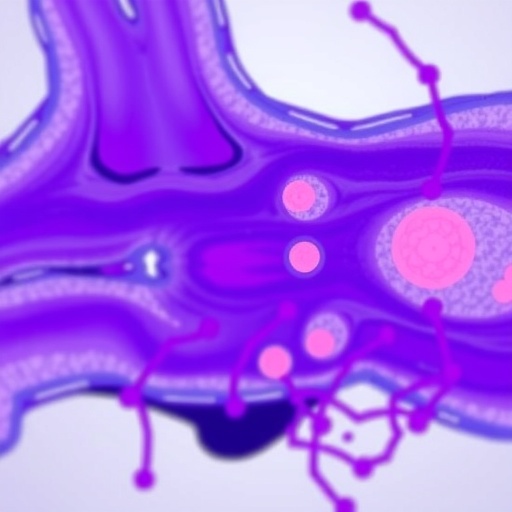
In a groundbreaking study published in Nature Communications, researchers have unveiled a novel cellular communication pathway that sheds new light on the progression of osteoarthritis (OA), a debilitating joint disease affecting millions worldwide. The team, led by Liu, Ma, Gong, and colleagues, discovered that osteocytes—specialized bone cells embedded deep within the mineralized bone matrix—release extracellular vesicles (EVs) that orchestrate direct molecular crosstalk between bone and cartilage tissues. This intercellular communication appears to significantly exacerbate osteoarthritis progression, opening the door to innovative potential therapeutic strategies aimed at disrupting these vesicle-mediated signals.
Osteoarthritis has traditionally been understood as a cartilage-centric disease characterized by cartilage degradation, subchondral bone remodeling, and chronic inflammation culminating in joint pain and loss of mobility. However, this classical view has increasingly been challenged by accumulating evidence highlighting the integral role of bone in OA pathology. Osteocytes, the most abundant cells in bone, have long been proposed as key mechanosensors, capable of translating mechanical stimuli into biochemical signals. Yet, how these cells communicate with chondrocytes—the primary cells of cartilage—to influence joint homeostasis had remained elusive until now.
The present study rigorously investigates the molecular cargo of osteocyte-derived extracellular vesicles and their impact on chondrocyte biology. Extracellular vesicles, nano-sized membrane particles secreted by virtually all cell types, are increasingly recognized as pivotal mediators of intercellular communication, transporting proteins, lipids, nucleic acids, and signaling molecules. Liu and colleagues utilized state-of-the-art high-resolution imaging, proteomics, and transcriptomic analyses to profile the composition of these vesicles from osteocytes under both physiological and pathological conditions mimicking OA.
Their findings reveal a complex vesicular cargo enriched with a unique subset of microRNAs, cytokines, and matrix-degrading enzymes that collectively modulate chondrocyte behavior. Notably, these osteocyte-derived EVs were shown to promote catabolic activity within cartilage, enhancing the expression of enzymes such as matrix metalloproteinases (MMPs) and aggrecanases that accelerate extracellular matrix breakdown. This discovery elucidates a direct molecular mechanism by which bone cells contribute to cartilage deterioration in OA, redefining the interplay between these two pivotal tissues within the joint.
In addition to their degradative influence, the vesicles impacted chondrocyte inflammatory responses, inducing upregulation of pro-inflammatory mediators including interleukin-6 (IL-6) and tumor necrosis factor-alpha (TNF-α). This inflammatory milieu fosters a vicious cycle of joint tissue damage and immune activation, further amplifying OA progression. Critically, the study demonstrated that inhibiting extracellular vesicle secretion from osteocytes markedly attenuated both cartilage destruction and inflammation in preclinical OA models, underscoring the therapeutic potential of targeting this pathway.
Mechanistically, the authors linked the release of these vesicles to alterations in osteocyte mechanotransduction pathways, whereby changes in mechanical loading modulate vesicle secretion profiles. This finding bridges the previously disparate fields of bone biomechanics and joint biology, highlighting how mechanical cues perceived by osteocytes translate into biochemical signals that directly influence cartilage integrity. Such insights have profound implications for understanding age-related and injury-induced osteoarthritis, conditions often accompanied by altered joint mechanics.
Liu and colleagues employed advanced animal models replicating human OA pathology to validate their in vitro observations. Using fluorescent labeling and intravital microscopy, they tracked osteocyte-derived EVs in vivo, confirming their delivery to cartilage tissue. The subsequent activation of chondrocyte catabolic pathways in vivo provided definitive evidence that these vesicles serve as functional messengers in the bone-cartilage axis, rather than merely byproducts of disease states.
Furthermore, the study explored the potential heterogeneity of EV populations, noting that different vesicle subtypes possess distinct functional roles. This nuanced characterization paves the way for designing targeted interventions that selectively block pathogenic vesicles while preserving those involved in joint repair and homeostasis. Identification of surface markers unique to osteocyte EV subsets also enables the development of biomarker assays for early OA diagnosis and progression monitoring.
The implications of these findings extend beyond basic science, as they challenge existing paradigms of osteoarthritis diagnosis and treatment. Current therapies predominantly focus on symptomatic relief and cartilage preservation but do not address the contributory role of bone cells in disease evolution. Targeting osteocyte-derived EVs thus represents an innovative approach with the potential to halt or even reverse joint degeneration by modulating the intercellular communication network within the joint microenvironment.
In light of this discovery, the research community is expected to intensify investigations into the regulatory mechanisms governing EV secretion and cargo loading in osteocytes. Understanding how systemic factors such as aging, metabolic syndrome, or hormonal changes impact vesicle-mediated bone-cartilage crosstalk will be paramount for translating these insights into clinical applications. Moreover, integrating the knowledge of EV biology with emerging regenerative medicine approaches could yield combination therapies that enhance cartilage repair while mitigating deleterious inter-tissue signaling.
Beyond osteoarthritis, the paradigm of extracellular vesicle-mediated communication between structurally and functionally distinct tissues may hold relevance in other musculoskeletal disorders, including osteoporosis, rheumatoid arthritis, and fracture healing. This study thus represents a seminal advance in the broader field of extracellular vesicle research, illustrating how vesicles serve as versatile conduits of intercellular dialogue in complex tissue systems.
The discovery also invites reevaluation of joint biomechanics and loading regimens as modifiable risk factors influencing EV release and joint health. Exercise and physical therapy protocols might be optimized to modulate osteocyte signaling favorably, emphasizing a personalized medicine approach to OA prevention. In parallel, development of pharmacological inhibitors that specifically impair osteocyte EV biogenesis or uptake offers promising therapeutic avenues currently unexplored.
Taken together, the pioneering work by Liu, Ma, Gong et al. not only reshapes our understanding of osteoarthritis pathogenesis but also catalyzes a new era of research focused on extracellular vesicle-mediated tissue crosstalk. As the burden of OA continues to escalate globally, fresh insights into its cellular and molecular underpinnings are desperately needed to drive innovation toward curative treatments.
Future research emergent from this study’s findings will likely dissect the precise signaling pathways and molecular triggers that govern osteocyte EV dynamics in homeostasis versus disease. The integration of single-cell omics, super-resolution imaging, and bioengineered joint models promises unprecedented resolution in unraveling the complexity of the bone-cartilage interface.
In summary, this compelling research highlights the central role of osteocyte-derived extracellular vesicles as critical mediators of pathologic communication between bone and cartilage in osteoarthritis. Their ability to propagate catabolic and inflammatory signals essential to joint degeneration suggests new molecular targets for therapeutic intervention. The study profoundly advances our mechanistic comprehension of osteoarthritis, encouraging optimism for breakthrough treatments targeting the bone-cartilage axis with precision.
Subject of Research: Osteocyte-derived extracellular vesicles and their role in mediating bone-cartilage communication and osteoarthritis progression.
Article Title: Osteocyte-derived extracellular vesicles mediate the bone-to-cartilage crosstalk and promote osteoarthritis progression.
Article References:
Liu, N., Ma, Y., Gong, W. et al. Osteocyte-derived extracellular vesicles mediate the bone-to-cartilage crosstalk and promote osteoarthritis progression.
Nat Commun 16, 4746 (2025). https://doi.org/10.1038/s41467-025-59861-5
Image Credits: AI Generated
Tags: bone-cartilage communicationcartilage degradation mechanismscellular communication pathwayschondrocyte biologyintercellular signaling in jointsjoint disease researchNature Communications studyosteoarthritis progressionosteocyte extracellular vesiclesosteocyte mechanosensorssubchondral bone remodelingtherapeutic strategies for osteoarthritis





